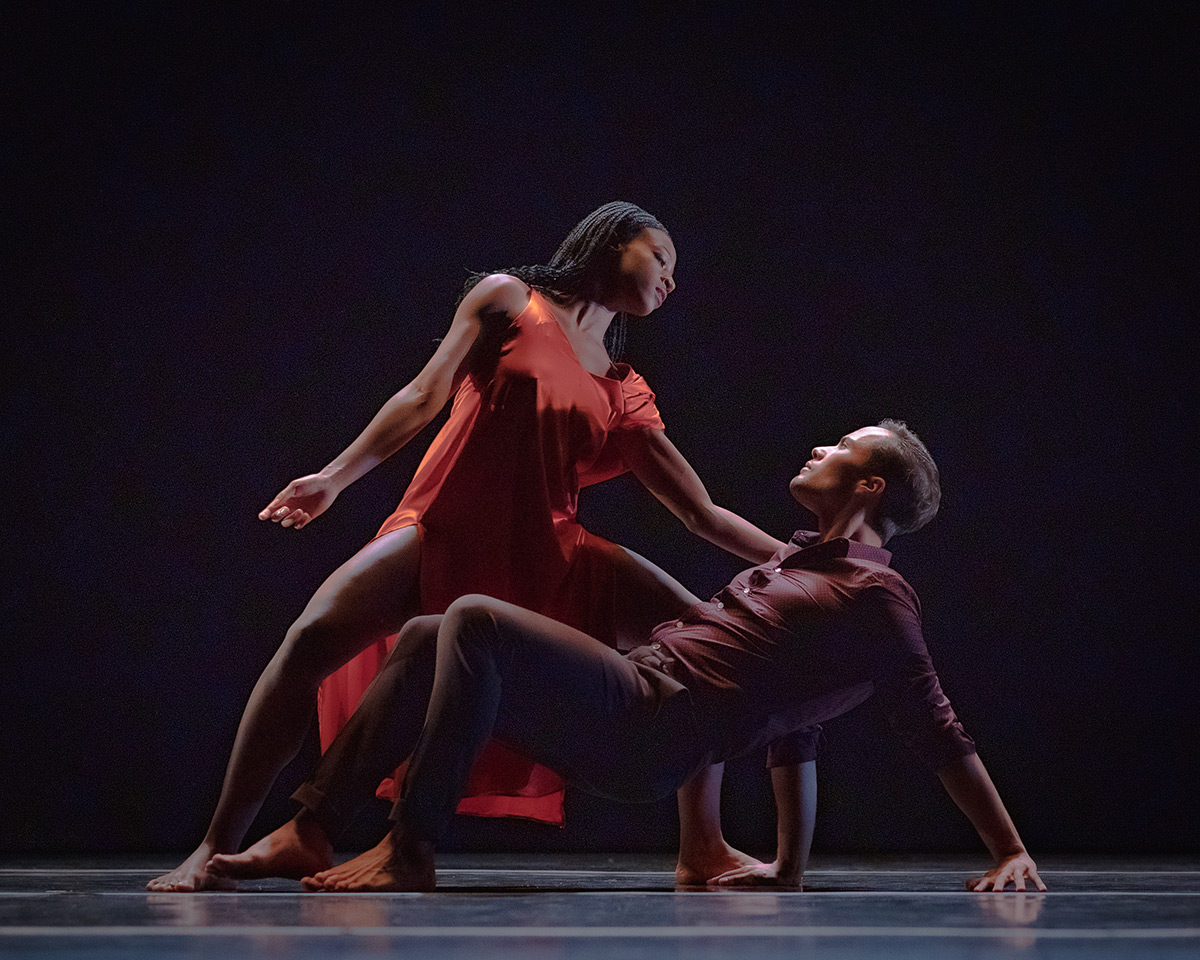
© Brian Pollock. (Click image for larger version)
Martha Graham Dance Company
Program A: Diversion of Angels, Immediate Tragedy, Scavengers, Appalachian Spring
★★★★✰
New York, Joyce Theater
26 October 2021
Feature on Andrea Miller at the Martha Graham Dance Company making Scavengers
marthagraham.org
www.joyce.org
On Human Nature
The opening night program of the Martha Graham Dance Company’s current New York City season at the Joyce Theater served up generous and satisfying nourishment for the human soul. The program included popular Graham masterpieces alongside new works coalescing around the theme of the human yearning for connection – in life and death and love – a resonant choice given the social impacts of the pandemic with its lockdowns, isolation, and death.
Martha Graham’s 1948 classic Diversion of Angels opened the bill with its rendering of different shades of love. Artistic director Janet Eilber, in her spoken introduction, offered that the choreography’s off-balance poses and topsy-turvy sprints and jumps speak to that quality of emotion in the experience of love. Set against an azure blue backdrop, Diversion features three female dancers – one costumed in white, one in crimson, and one in yellow. According to Eilber, they may either represent three different women and their experiences of love or one woman at three different stages of life. Natasha M. Diamond-Walker performed the sweeping movements and poses of the Woman in White with a calm, steady maternal presence evoking mature love. The Woman in Red dances a representation of passionate love and its mixture of joy and pain with the signature motif of a torso tilted to the side with a leg extending sideward that culminates in the sudden pinch of a contraction. So Young An performed the role with notable energy. However, her limitless flexibility sometimes prevented her from arriving at a defined end point in her movements. Marzia Memoli epitomized the playful, flirtatious energy of the Woman in Yellow. Her countless jumps and leaps were so springy, she seemed not to touch floor.
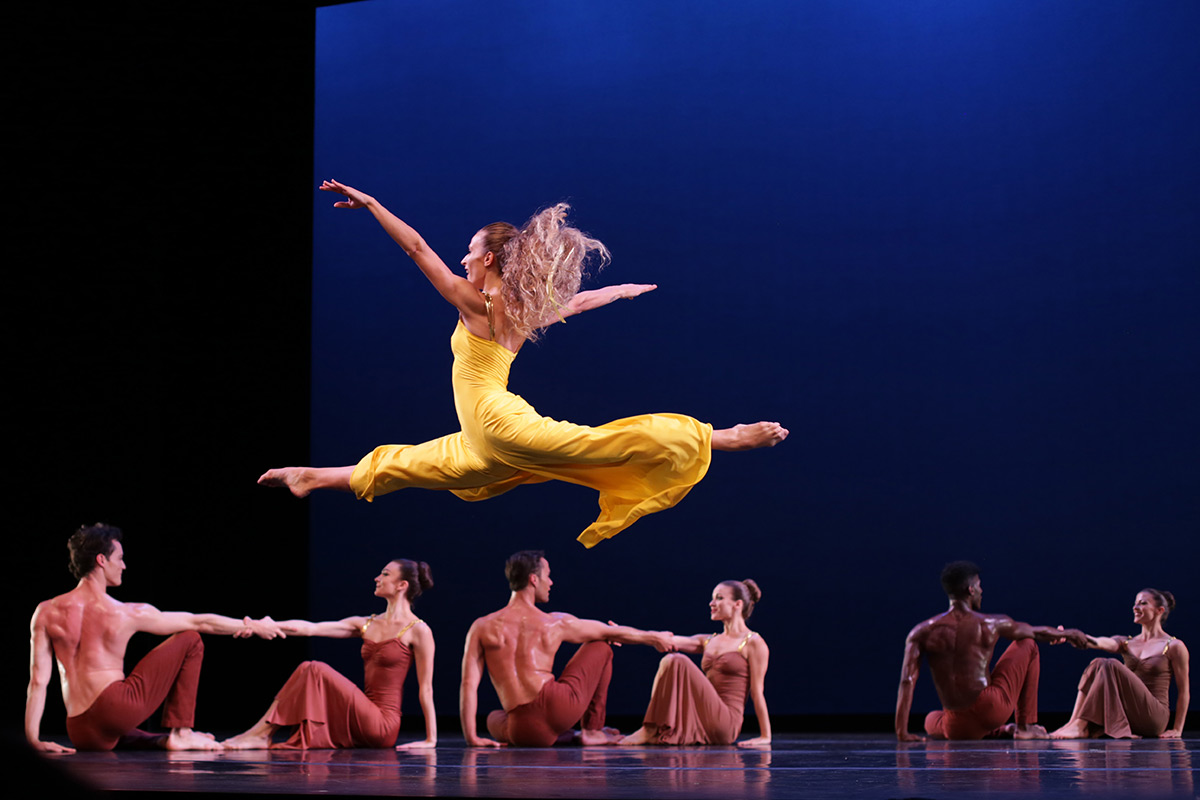
© Melissa Sherwood. (Click image for larger version)
The four men, who sometimes partner the women and at other times form a male chorus, are wonderfully organic movers and filled each movement with expansive physicality. The four women of the female chorus were equal to the technically demanding role but again suffer from an inability to complete distinct poses and actions given their awesome range of motion. The dance and its dynamic score by Norman Dello Joio gathers exciting intensity towards the end as the chorus of men jumping with primal energy encircles the Woman in White. The dancers’ timing was perfect as the Woman in Red strode her long diagonal across the stage at full throttle as the score drove to the final chord, which sounded just as the Woman in White was framed with an archetypal crown formed out of the hand gesture of her partner.
Two new works added complementary voices to the program’s thematic conversation. Janet Eilber’s reimagined Immediate Tragedy drew inspiration from a lost Graham solo from 1937 dedicated to the struggle of women during the Spanish Civil War. In 2020, the Graham Company released a digital version of Immediate Tragedy referencing the lost solo. Eilber, working remotely with 14 dancers, had coalesced the digital piece using dance poses from recently discovered photos of the solo. I was excited by the new creation – the reimagined music by Christopher Rountree, the heartfelt dancing, and the innovative digital design, in which the Zoom grid was choreographed as a dynamic element of the dance. How would this now be staged for live performance? Immediate Tragedy for the stage was reimagined as a simple solo. There were no bells and whistles – just a magnificent dancer performing a powerful dance of defiance in a white t-shirt and long, full black skirt with a rich red lining that flicked into view with every kick of the leg. The solo was movingly performed on opening night by Xin Ying, who alternates the role with Anne Souder, another exquisite dancer.
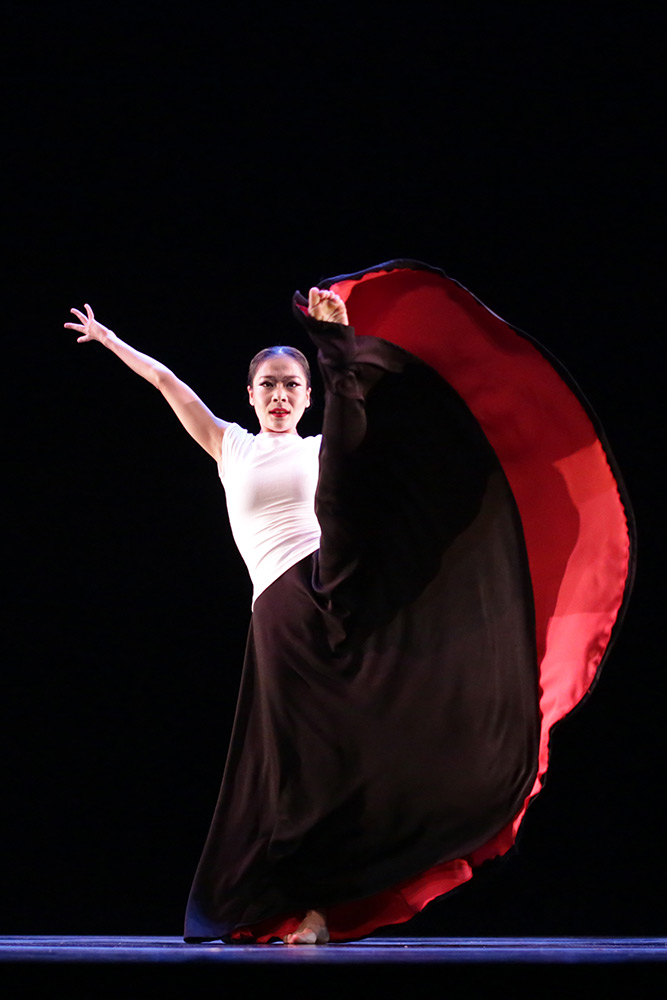
© Melissa Sherwood. (Click image for larger version)
The initial somber piano tones wash over the dance with sadness as the dancer slowly bends backward to the floor seemingly overpowered by a great force. She rises back up defiantly only to be pulled in opposing directions by tensions that also turn her around in circles as she raises her clenched fists with upper body arched in a hint of Spanish dance. Proceeding forward on her knees, her fierce determination reverberates (literally) through each labored step. Then she stands upright and continues forward – the look in her eyes daring anyone to try and knock her down. I’m hoping that one day, the company will introduce a third version, in which the digital creation is projected onstage behind the live soloist – just a thought.
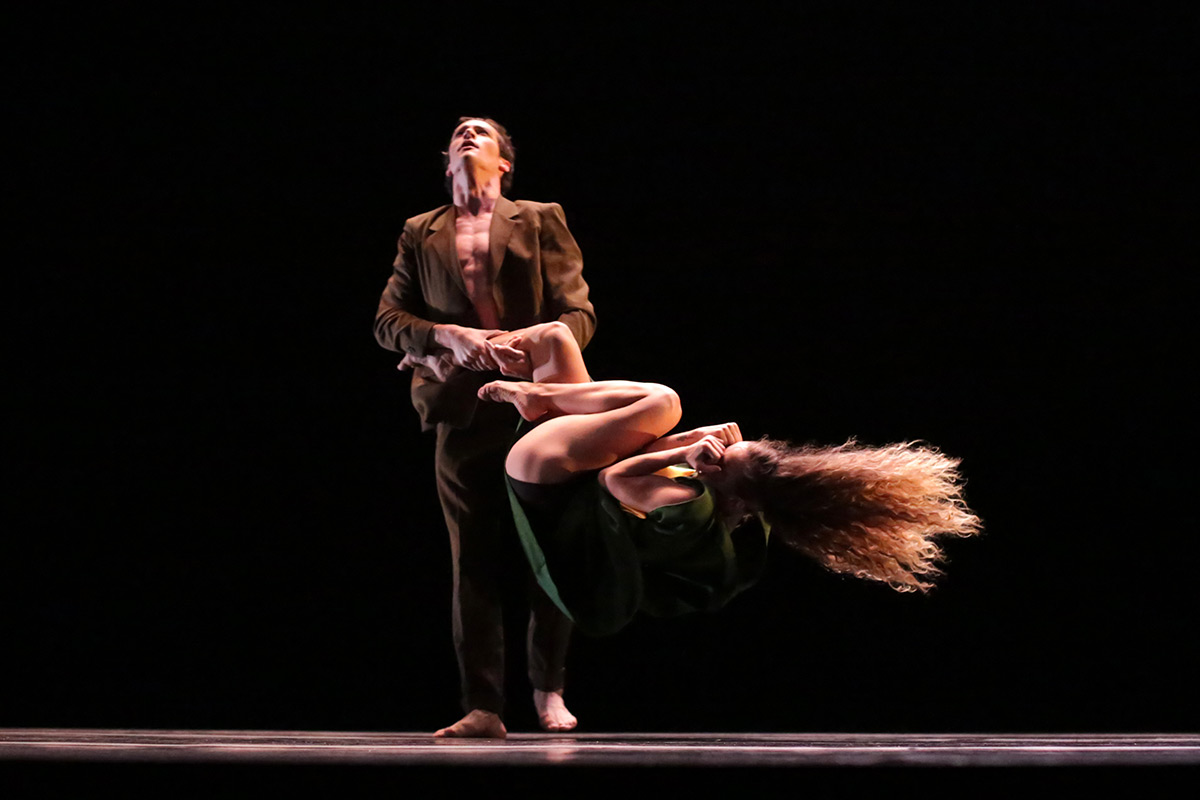
© Melissa Sherwood. (Click image for larger version)
The new commission Scavengers by Andrea Miller held its own next to the Martha Graham works and was well received by the audience. In the four duets and solo that comprise the work, Miller creates a safe space, or haven, where people can explore and find connection without restraint – on a dance floor. Four couples each offer a different flavor of scavenged relationship wonderfully embodied in novel and expressive ways. For example in the first duet, Leslie Andrea Williams connects with her partner Alessio Crognale, who is lying on the floor, by hooking her foot around his. She then nudges him around as she walks with a graceful limp. Some of the couples erupt in innovative and beautiful lifts repeating the display like fireworks. The music composed for the piece by Miller’s frequent collaborator, Will Epstein, framed each section in an evocative soundscape. This was particularly evident in the sultry strains accompanying the steamy duet (number two) danced by Jacob Larsen and Marzia Memoli. Whether their bodies were connected or apart, the magnetism accentuated by the music was intense and palpable. My only dissatisfaction is that the duets felt like quick introductions. I would have liked to have remained with each one longer. The final challenging solo danced capably by Anne Souder remained an enigma. Was she yearning for another or was she satisfied in her solitude? I couldn’t really tell.
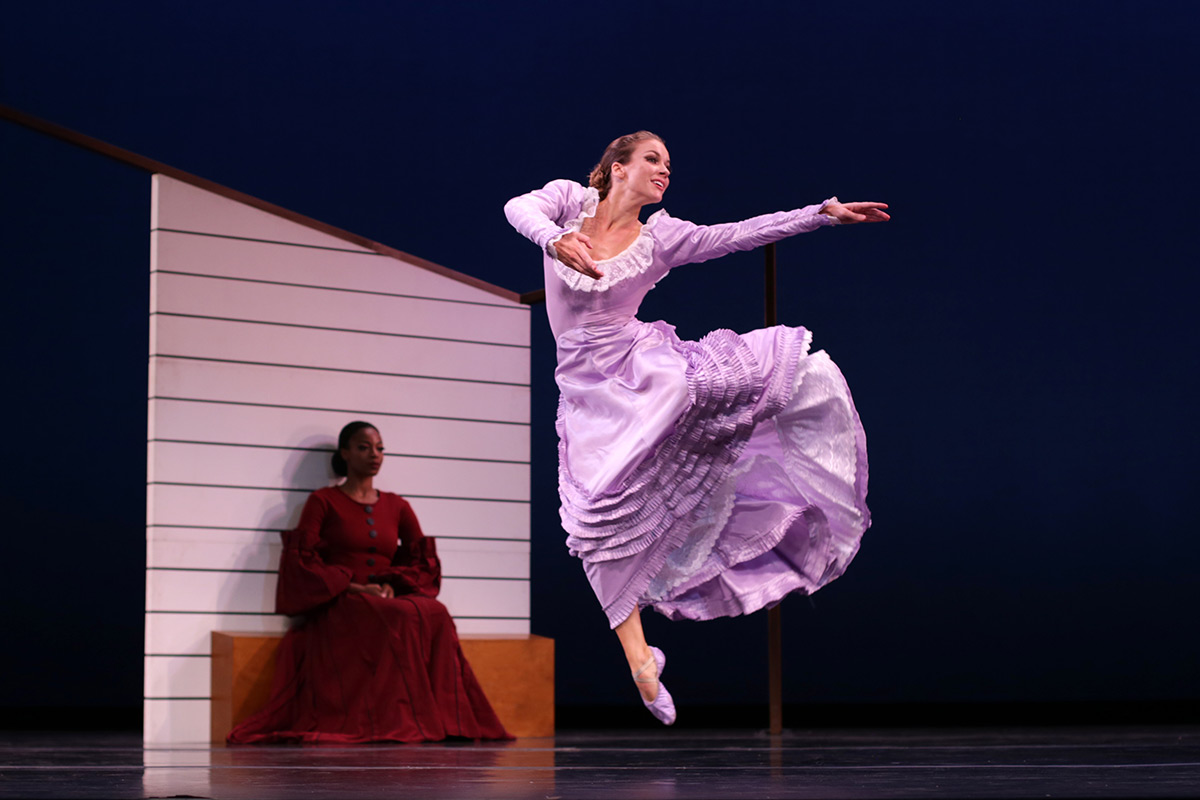
© Melissa Sherwood. (Click image for larger version)
Martha Graham’s Appalachian Spring, with its enduring orchestral score by Aaron Copland and minimalist but suggestive set design by Isamu Noguchi, completed the evening with its 1940s vision of optimism and conviction in the American Dream. Anne O’Donnell and Lloyd Mayor convincingly danced the roles of the Bride and Husbandman respectively, a portrait of big dreamers and their fervent belief in the ability to achieve them. Lloyd Knight danced the Preacher with less sharp attack and fanatical severity than some other interpretations of the role. Perhaps preachers today are more forgiving. The chorus of four Followers were in tip-top shape performing their pious antics with crisp precision allowing the attendant humor to naturally emerge. Leslie Andrea Williams fully inhabited the role of the Pioneering Woman providing a common vision and space for this community of distinct participants.
The program notes opened with this quote from Martha Graham, “The instrument through which the dance speaks is also the instrument through which life is lived – the human body. It holds in its memory all matters of life and death and love.” This statement clearly holds profound truth – otherwise, there would not have been such a rapturous standing ovation for the human expression so eloquently delivered onstage.













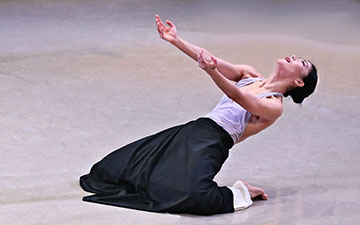

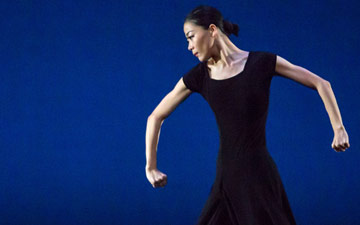

You must be logged in to post a comment.